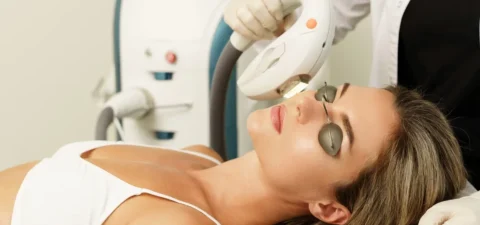All content in this blog is for informational purposes only. It is not medical or legal advice. Please consult with a lawyer or a medical professional.
Aestheticians are a class of skin-care specialists who have undergone extensive training in cosmetic treatments. They use cosmetic items and tools in their work. The majority of an aesthetician’s work is giving facial treatments and performing surgical procedures to enhance one’s appearance. An aesthetician must also be able to perform massages, waxing, and scrubs.
So how does one become an aesthetician, and how much formal education is typically required to become a licensed practitioner of aesthetic? Typically, skincare professionals such as aestheticians require to attend some form of cosmetic school before they can get a state license to practice in a clinic setting.
How Much Schooling to Be an Aesthetician?
Medical estheticians must complete cosmetology or esthetician school and become state-licensed when they graduate. Estheticians often enroll themselves in specific surgical training, such as learning how to utilize lasers for skin treatments or hair removal. This helps them gain the certifications and credentials that make them eligible to work at dermatology offices, hospitals, and clinics.
To become a professional aesthetician, one must complete relevant coursework from a certified cosmetology school, a two-year university program, or other schools that are specifically designed for these courses. These courses combine classroom learning with practical experience to equip students with the skills they need to pursue careers in this field.
To qualify for a state license, students must finish a certain amount of course hours. Students often need to finish a specified number of treatments to show their proficiency and expertise in order to graduate.
After finishing their basic esthetician programme, students who want extra training can enroll in specialized medical esthetician courses. These courses can cover skills that require hands-on instruction, such collagen injections or laser hair removal, and can range in length from a few days to a few weeks.
Admission Criteria for Medical Aesthetician Programs
The location, caliber, and length of the programme all affect the admission standards for esthetician programmes. For the majority of schools, the only prerequisites are that applicants have a GED or have completed high school.
Skills Required to Become a Aesthetician
Ideally, upon completion of a certified course in cosmetic medicine or medical aesthetics, a student must be able to possess a certain set of skills pertaining to surgical treatments, non-surgical procedures, and non-invasive medical procedures. The following skills can help one excel in the field of medical aesthetics:
- Ability to communicate effectively and understand a patient’s needs
- Ability to perform treatments such as waxing and facials
- Ability to administer treatments such as chemical peels, laser treatments, and hair removal procedures.
- Ability to skillfully perform surgical procedures, microdermabrasion treatments, botox injections and dermal filler surgeries.
- Ability to apply makeup and provide facial/neck massages
- Ability to prescribe pre-surgery and post-surgery skincare tips according to the patient’s condition
Accreditation of Aesthetician Courses
There are a number of councils that are responsible for accrediting courses in cosmetics and aesthetic medicine. These include Accrediting Council for Continued Education & Training (ACCET), Accrediting Commission of Career Schools and Colleges (ACCSC), National Accrediting Commission of Career Arts and Sciences (NACCAS), and Council on Occupational Education (COE).
Students should check the accreditation status of the programme they choose to enroll in because this guarantees a minimum standard of educational quality as well as compliance with course and content criteria. While not necessary for licensing, attending an authorized programme can increase your chances of getting hired.
A Step-By-Step Guide to Become a Medical Aesthetician
Step 1: High-School Graduation or Equivalent GED
Most medical esthetician schools require applicants to have completed high school or hold a GED. To prepare for this vocation, students should concentrate on courses in biology, chemistry, and anatomy. Additionally, as effective communication is crucial while working closely with clients, students can benefit from taking psychology and creative writing classes to develop skills that will help them succeed as medical estheticians.
Step 2: Medical Aesthetician Course or Training Program
One must complete a certified course or training program in medical aesthetics or cosmetology from an accredited institute to become a professional aesthetician. The tenure of the program can vary depending on the school, mode of study, and degree being pursued. Most schools offer courses that can take anywhere from 9 months to two years to complete.
In all programmes, students take a mix of lecture courses in a classroom setting followed by practical training. Completing the prescribed amount of experience hours and treatments is a requirement for graduation in the majority of programmes.
Step 3: State Licensure for Practicing Aesthetic Medicine
Obtaining a state license for practicing aesthetic medicine and performing cosmetic procedures in clinics is the most important step to becoming a professional aesthetician. Not every state has the same regulations regarding licensing and the requirements vary from state to state. Generally speaking, certifications for showing completed coursework and proving competence through an examination should suffice.
Popular Schools and Colleges That Offer Aesthetician Courses
On-Campus Programs
West Georgia Technical College
Students can obtain a certificate in aesthetics at West Georgia Technical College. This entry-level course is intended for learners with no prior expertise in the subject. This program’s main goals are to equip students to become exceptional estheticians and to provide graduates with the necessary preparation for passing the state licensing exam.
It should be noted that Georgia requires students to take their state licensing exam within 24 months of earning all of the necessary credits. Eight credits of aesthetics practicums are also required of students in order to ensure that they have the necessary practical training for this line of work.
Salon administration, introductory aesthetics, skincare techniques, anatomy and physiology of the skin, color theory, and makeup are compulsory courses that are required to earn this certificate.
It’s a nine month program offered at Carrollton, Georgia that is accredited by the Southern Association of Colleges and Schools Commission on Colleges. The cost of this course is about $100 per course credit and $326 per term of schooling.
Aveda Arts & Sciences Institutes
Across the nation, Aveda has established itself as a reputable brand of high-end salons and spas. Applicants need to have specific training with their products and treatments in order to work at one of their clinics or spas.
Graduates of the Aveda Arts & Sciences Institute graduates can acquire a state license as a virtue of the experience they gained through their medical esthetician courses. The specialized training in plant and flower essence based skin therapy that comes as part of the course generally costs about $10,000 per year of study.
The length of this programme varies depending on the state’s licensing requirements, where it is finished. The majority of programmes last for at least 27 weeks and 750 hours. Students take part in skincare theory, practice, and clinical studies. To ensure proficiency in all facets of medical esthetician care, students will complete quizzes, demonstrations, and practical tests throughout the curriculum.
Paul Mitchell The School Sacramento
Students at Paul Mitchell receive training not just to become elite estheticians but also to become savvy business executives. The three levels of classes in this nine-month programme teach students the fundamentals of skincare as well as how to apply and go beyond those rules. The tuition fees for the entire program is about $8,750 and roughly covers about 600 hours of coursework.
Skin types, infection control techniques, sanitation, knowledge of skin physiology, how to conduct consultations, hair removal techniques, chemical treatments, and state laws are just a few of the technical subjects addressed in this type of schooling. The professional kit, which contains top-notch Paul Mitchell tools and products, is something that students are expected to buy as part of the program.
College of the Mainland
Students can finish the College of the Mainland’s esthetician certificate program in approximately nine months to become a certified aesthetician. Graduates of this course are prepared to tackle the Texas Department of Licensing and Regulations’ licensing exam for aesthetics. The cost of the program is about $3800 for every two semesters of course work.
Students must complete 20 semester-credits of curriculum, which includes specialized training in the uses of face and skincare technology, an overview of salon trends, and preparation for the license exam. In addition to their academic work, students acquire practical experience in the school salon by performing facials, chemical peels, waxings, and anti-aging procedures.
Santa Monica College
For students who wish to learn about all facets of salon care, including aesthetics, Santa Monica College offers a two-year associate’s degree in cosmetology, or a shorter aesthetics certificate for those who want to concentrate on the face and skin. While the study required to become an esthetician for the associate’s degree and the certificate are quite similar, the certificate offers more in-depth coursework on mechanical and chemical exfoliation.
Students must achieve 13 credits of required coursework to complete the aesthetics certificate, compared to 25.5 for the associate’s degree. The certificate requires 600 hours of training and practice, whereas the associate’s degree requires 1,600. In California, those who get an associate’s degree are entitled to apply for a cosmetology license, while those who earn a certificate can apply for an esthetician license.
Citrus Community College
The skills needed to assist clients in achieving and maintaining healthy skin can be learned by students enrolled in the Citrus College Esthetician program. Students will get to hone their skills in both classroom and practical settings during the nine-month program. In addition to a two-year associate of science (AS) in cosmetology, Citrus College also provides an esthetician certificate of achievement. The course costs about $317 per course credit.
Three levels of esthetician curriculum as well as 600 hours of practical practice are prerequisites to obtain certification from the college. Students will learn effective hair removal techniques, facial treatment suggestions depending on skin type, makeup application techniques, sanitation practices, and disinfection techniques. Graduates are qualified to take the California State Board of Barbering and Cosmetology Esthetics license examination.
Online Schools and Courses
Evergreen Beauty College
Evergreen Beauty Colleges are aware that not every student is a good fit for the intense structure used by the majority of beauty colleges. Evergreen takes lessons for four hours every day, as opposed to three or four days of eight to ten hours of coursework and practice. After that, students must finish online coursework and other assignments.
With this flexible arrangement, students are able to work or take care of a family while pursuing a profession in medical aesthetics. Under the supervision of teaching personnel, students must still conduct practical procedures and treatments. The first phase consists mostly of in-classwork, while the second involves learning how to work with clients directly. An internship and training for Washington board certification make up the third and final component.
Nima Institute
Nima Institute offers a hybrid-style course on aesthetic medicine. With over 1200 hours of course training, students must complete this course through online classes, assessments and occasional live classes on-campus. The tuition fee is about $16,000 for the entire course.
This program’s distinguishing feature is that students are trained by subject-matter experts with actual work experience, giving them a unique perspective that is not merely based on textbook information.Students who successfully complete this course will be prepared academically and professionally to obtain their master esthetician license in the state of Utah.
Get Certified Training Courses At FACE Med Store
Certified training courses in aesthetic medicine from schools and colleges can be expensive. Also, aspiring professionals may need to take up additional courses for learning to perform specialized treatment in different niches. At the FACE Med Store, we offer comprehensive training programs that offer you a perfect blend of hands-on experience and subject knowledge.
Our specialists and training videos will help you find a speciality that suits your interests and will teach you to perform treatment procedures such as treating burns, pre-surgery and post-surgery procedures. Feel free to go through our course catalog to find courses that can help you become a professional aesthetician. Contact us today to learn more about our medical products that can also help you perform cosmetic procedures in clinical settings.






